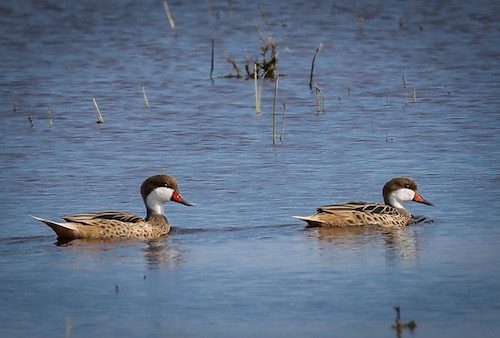White-cheeked Pintail
White-cheeked Pintail (Anas bahamensis), also commonly known as the Bahama Pintail, is a marsh duck with incredibly distinctive plumage. White-cheeked pintail bills, in comparison to their face, appear very large. They are mostly black or gray with a red flare present on either side of their nares. This red is also seen in their small irises. Individuals have a brown cap that stops just below the eyes and extends down the back of their neck and onto their back. The white cheeks, their namesake, are bold and contrasts highly on the males, though the female’s cheeks are more dainty, somewhat reminiscent of a porcelain doll. The chest, flanks, and underbelly are tan-brown with cascading dark brown spots that get larger the closer they are to the underbelly. White-cheeked pintail wings are mostly brown with a beautiful iridescent green speculum that is edged with black on the side closest to the secondaries. The green and black are outlined on either side with bold, bright, tan secondary and median coverts.
White-cheeked Pintail. Easily the most elegant of Argentina duck species, sprigs the color of farm fresh cream. And check out the way that speculum pops! Seems like almost always decoy in singles and pairs, sometimes small flocks of half-dozen. Over the decoys, find myself focusing on the bright white cheek patch, sometimes noticing the the bright red indicative of adult drakes. Good focal point while instinctively shouldering gun. Argentina and coastal Peru are the very best places to hunt white-cheeked pintails.

Available Hunts
-
Argentina Duck Hunt – Parana River Delta
An Argentina duck hunt destined to become absolute legend, the Parana River Argentina duck hunting an immersive adventure in one of the wildest places ever.
...read more- Wildest, most remote duck hunt in Argentina, pure adventure
- Luxury liveaboard accommodations, < 15 minutes from duck blind
- Amazing gourmet meals, excellent wine selection (an Argentina wine tasting offered each week)
- Located about 4-5 hours travel from downtown BA, last 1.5 hours by boat
- Rosy-billed pochards, white-cheeked pintails and teal predominate the bag
- Choose high-volume ducks twice daily, or afternoon golden dorado fishing
Rate: $975 -
Argentina Duck Hunting Las Flores
High-volume Argentina duck hunting is a "real duck hunter's duck hunt" that consistently produces over-the-top action. You've tried the rest, now come try the very best!
...read moreArgentina duck hunting Las Flores is our poster-boy Argentina duck hunt. For over a decade, this operator consistently delivers generous duck limits without fail. Convenient hunt that all duck hunters will enjoy.
- Fun, fast-paced duck hunts, generous limits every single day without excuses
- Tons decoying rosy-bills, all Argentina species available
- Located 5.5 hours from EZE, < 30 minutes to blinds
- Great lodging, superior meals, best-stocked bar in Argentina
- As featured MOJO TV; Wildfowl, Predator Nation, Peterson’s and Trigger, Field & Stream, more
Rate: $1,150 -
Argentina Duck Hunting Rio Salado
High-volume Argentina duck hunting a remote wetland that's well worth the effort.
...read moreArgentina duck hunting Rio Salado for die-hard duck hunters that will go the distance for high-volume shooting, high species diversity, and unspoiled habitat. Welcome to real Argentina.
- NO LONGER BOOKING THIS HUNT!
- Remote 74,000-acre wetland
- 1 hunter per blind unless requested
- Pure duck hunting
- Bilingual hosting for the entire trip
- Featured MOJO TV, Outdoor Life, Wildfowl, Sports Afield
Rate: N/A -
Peru Duck Hunting
Peru duck hunting trip for greatest concentration of Cinnamon Teal in the world
...read more- Highest density of cinnamon teal in the world
- Liberal limits, moderately easy walk in hunts, waders or hip boots suggested
- Hotel accommodations, restaurant meals of regional specialties
- Expert guide services and translation
- Combine with Mountain species
- Season May 1 – Nov 30
Rate: $850
While normally found in the Caribbean, South America (the coast of Ecuador and Peru, southern Chile, northern coast of Columbia and Venezuela, southern Bolivia, Paraguay, Argentina, and the east coast of Brazil), and the Galapagos Islands, White-cheeked Pintail there is only 1 recognized subspecies. Their natural habitat in South America are slightly saline or freshwater wetlands, which includes brackish lakes, estuaries, and mangrove swamps. Incredible popularity of this species for avian collections has led to individuals or small flocks of escapees living in Europe.
White-cheeked Pintail are considered monogamous for a single breeding season. There have been reports of polygyny (females having multiple male partners) because the male that she paired with is not attentive and leaves his own territory for long periods of time. Nests are built under dense, grassy vegetation that is close to a calm and quiet water source. Females are the only parent that incubate and rear the young. This is a dabbling species and their diet consists of aquatic plants and invertebrates near the surface of shallow waters.
WHITE-CHEEKED PINTAIL. One of my favorite Argentina duck species, it was also among the last species encountered during early visits there. They’re rarely found in river systems in northern Argentina. Their distinctive whistles and flight patterns are familiar to anyone that’s decoyed northern pintail, their shorter, blonde sprigs clearly tell-tale visible. During early morning when the sun is just over the horizon, they’re plumage is a striking bronze, jade secondaries ensconced in shimmering golden chevrons, while over the decoys their bright white cheeks and blood-red bill bases catch your attention when excitedly shouldering your shotgun (especially the adult drakes like the one in photo). Typical of pintails everywhere, they prefer shallower parts of the marsh. No matter how many times it happens, they feel like a prize every time I pick one up.






















